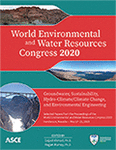World Environmental and Water Resources Congress 2020
Assessment of the Impacts of Sewerage Network on Groundwater Quantity and Nitrate Contamination: Case Study of Tehran
Publication: World Environmental and Water Resources Congress 2020: Groundwater, Sustainability, Hydro-Climate/Climate Change, and Environmental Engineering
ABSTRACT
Many communities in arid and semi-arid areas rely on groundwater for drinking water. However, anthropogenic activities such as the use of fertilizers and human waste disposal impose the risk of nitrate pollution to the aquifers. With over 8.5 million population, Tehran, the capital of Iran, has experienced rapid population growth during the past decades while the majority of the city did not have a sewerage network and the main way of wastewater disposal was individual cesspits inside houses. The long-term discharge of raw wastewater in cesspits has increased nitrate concentration in the Tehran aquifer which serves as a source of one-third of drinking water for the city. Although the construction of a sewerage network seems vital for improving the groundwater quality, one of the main concerns of this network is the drawdown of the water table in aquifer due to reduced recharge. A dynamic mass-balance model is developed for simulating water quantity and nitrate concentration in Tehran aquifer in order to study the impacts of sewerage network on the quantity and quality of groundwater. Considering that the sewage disposal in cesspits is one of the main sources of recharge, the results show the construction of sewerage network does not necessarily result in a reduction of nitrate concentration in long-term. This seems to be mainly because the reduced aquifer recharge results in groundwater depletion and the depleted aquifer is more prone to pollution even with smaller amounts of pollutants. Based on this modeling approach, we suggest that the reduced recharge due to construction of sewerage network should be compensated by either reduction of groundwater withdrawal or managed artificial recharge. The results of this study can provide a step toward application of sustainable water resources management in arid and semi-arid areas where the cesspits and septic tanks are common for wastewater disposal.
Get full access to this article
View all available purchase options and get full access to this chapter.
ACKNOWLEDGMENT
Parts of this work were done under a study entitled: Evaluating the impacts of implementing the sewerage system of Tehran City on water resources and land subsidence in the region and proposing corrective actions. Technical contributions of Dr. Mehrnia, Dr. Cheshomi, Dr. Nazif, Dr. Tabesh and the managers of the Tehran Regional Water Board Company are kindly hereby acknowledged.
REFERENCES
Bazargan-Lari, M.R., Kerachian, R., Mansoori, A., 2009. A Conflict-Resolution Model for the Conjunctive Use of Surface and Groundwater Resources that Considers Water-Quality Issues: A Case Study. Environ. Manage. 43, 470–482. https://doi.org/10.1007/s00267-008-9191-6
Geddes, J.A., Martin, R. V., 2017. Global deposition of total reactive nitrogen oxides from 1996 to 2014 constrained with satellite observations of NO 2 columns. Atmos. Chem. Phys. 17, 10071–10091. https://doi.org/10.5194/acp-17-10071-2017
Hajhamad, L., Almasri, M.N., 2009. Assessment of nitrate contamination of groundwater using lumped-parameter models. Environ. Model. Softw. 24, 1073–1087. https://doi.org/10.1016/j.envsoft.2009.02.014
Joekar-Niasar, V., Ataie-Ashtiani, B., 2009. Assessment of nitrate contamination in unsaturated zone of urban areas: The case study of Tehran, Iran. Environ. Geol. 57, 1785–1798. https://doi.org/10.1007/s00254-008-1464-0
Karimi, L., Motagh, M., Entezam, I., 2019. Modeling groundwater level fluctuations in Tehran aquifer: Results from a 3D unconfined aquifer model. Groundw. Sustain. Dev. 8, 439–449. https://doi.org/10.1016/j.gsd.2019.01.003
Khorasani, H., Kerachian, R., Malakpour-Estalaki, S., 2018. Developing a comprehensive framework for eutrophication management in off-stream artificial lakes. J. Hydrol. 562, 103–124. https://doi.org/10.1016/j.jhydrol.2018.04.052
Lerner, D.N., 2002. Identifying and quantifying urban recharge: a review. Hydrogeol. J. 10, 143–152. https://doi.org/10.1007/s10040-001-0177-1
MAOGCE, 2012. Studies of the use of Tehran’s treated wastewater. Technical report, Tehran, Iran (in Persian).
MGCEC, 2009. Studies of Tehran-Karaj Aquifer Optimal Water Withdrawal. Technical report, Tehran, Iran (in Persian).
Mohammadi, H., Yazdanbakhsh, A., Sheykh Mohammadi, A., Bonyadinejad, G., Alinejad, A., Ghanbari, G., 2011. Investigation of nitrite and nitrate in drinking water of regions under surveillance of Shahid Beheshti University of Medical Sciences in Tehran Province. Iran. J Heal. Syst Res 7, 782–789.
Rivett, M.O., Buss, S.R., Morgan, P., Smith, J.W.N., Bemment, C.D., 2008. Nitrate attenuation in groundwater: A review of biogeochemical controlling processes. Water Res. 42, 4215–4232. https://doi.org/10.1016/j.watres.2008.07.020
Salahi, A., Geranfar, S., Korori, S.A., 2001. Nitrogen deposition in the greater Tehran metropolitan area. Scientific World Journal 1 Suppl 2, 261–265.
Sharif University of Technology, 2014. Assessment of the quality and health impacts of Chitgar Artificial Lake and management plans. Technical report, Tehran, Iran (in Persian).
Uffink, G.J.M., 2003. Determination of denitrification parameters in deep groundwater: A deep pilot study for several pumping stations in the Netherlands. RIVM report.
Umezawa, Y., Hosono, T., Onodera, S., Siringan, F., Buapeng, S., Delinom, R., Yoshimizu, C., Tayasu, I., Nagata, T., Taniguchi, M., 2008. Sources of nitrate and ammonium contamination in groundwater under developing Asian megacities. Sci. Total Environ. 404, 361–376. https://doi.org/10.1016/j.scitotenv.2008.04.021
University of Tehran, 2018. Evaluating the impacts of implementing the sewerage system of Tehran City on water resources and land subsidence in the region and proposing corrective actions. Client: Tehran Regional Water Board Company, Technical Report (In Persian).
Information & Authors
Information
Published In
World Environmental and Water Resources Congress 2020: Groundwater, Sustainability, Hydro-Climate/Climate Change, and Environmental Engineering
Pages: 53 - 66
Editors: Sajjad Ahmad, Ph.D., and Regan Murray, Ph.D.
ISBN (Online): 978-0-7844-8296-4
Copyright
© 2020 American Society of Civil Engineers.
History
Published online: May 14, 2020
Published in print: May 14, 2020
Authors
Metrics & Citations
Metrics
Citations
Download citation
If you have the appropriate software installed, you can download article citation data to the citation manager of your choice. Simply select your manager software from the list below and click Download.
